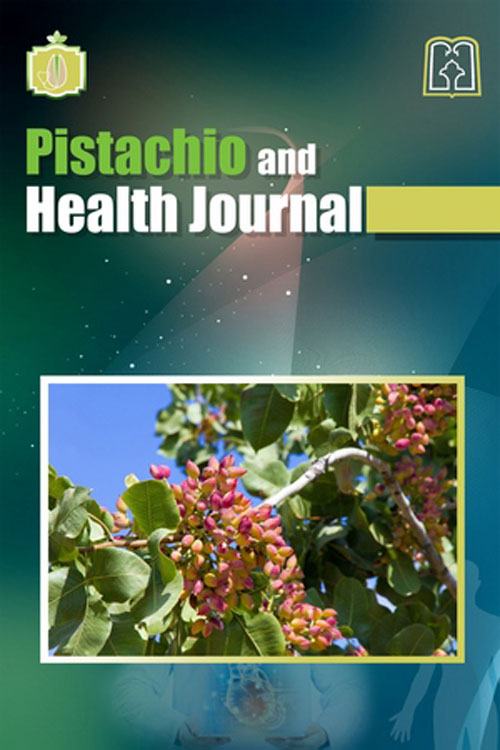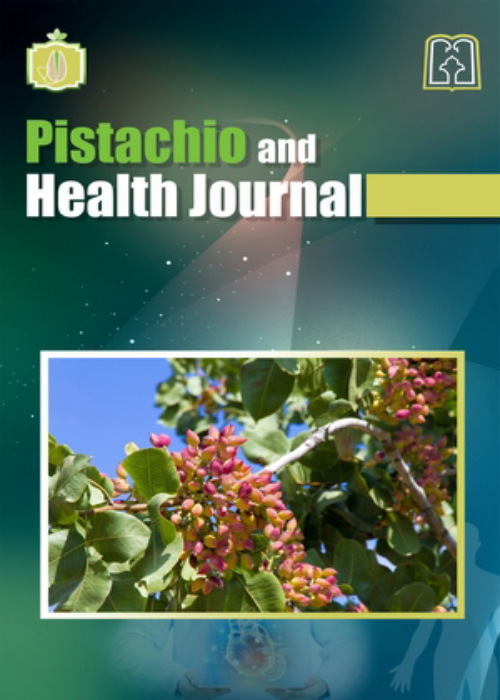فهرست مطالب

Pistachio and Health Journal
Volume:5 Issue: 1, Winter 2022
- تاریخ انتشار: 1401/02/13
- تعداد عناوین: 8
-
Pages 3-10Background and objectives
Pistacia vera seed (pistachio) is an edible seed with various therapeutic effects, such as antimicrobial, antioxidant, and anti- inflammatory properties. This study aimed to evaluate the oral wound healing effects of Pistacia vera seeds extracts (PSE).
MethodsThe hydroalcoholic pistachio extract was prepared by the maceration method. A wound was created in the central region of the tongue on the dorsal surface in each rat. The animals were randomly allocated to four groups (n=12). The treated groups orally received 0.5 ml/day of PSE (50, 100, or 200 mg/kg), and the vehicle group orally received 0.5 ml of 10% dimethyl sulfoxide. Each group was divided into three subgroups (n=4), and the animals were sacrificed on days 3, 7, and 10 to acquire the tongue specimens. The number of arteries, as well as the mean percentage of neutrophils, lymphocytes, and fibroblasts, was determined via histopathological examination.
ResultsThe administration of 50 mg/kg of PSE for 10 days showed a beneficial effect on the number of neutrophils and fibroblasts.
ConclusionThe present study showed that the hydroalcoholic extract of pistachio could be considered a potential treatment for oral wounds.
Keywords: wound healing, Pistacia, Rat -
Pages 11-21Background
The most effective aflatoxin prevention strategy is limiting populations of toxigenic Aspergillus flavus strains using non-toxigenic strains, as a biological method.
Materials and methodsTen different vegetative compatibility groups (VCGs) of A. flavus strains (5 toxigenic and 5 non-toxigenic) isolated from the fruit and soil of pistachio orchards were used for the purpose of this study. Next, an equal population of spores of each isolate was mixed together and cultured on a coconut agar medium (CAM) and incubated in the dark at 30 °C for 3 days. On the other side, 20 gr of a mixture containing soil, peat, and pistachio powder was inoculated with the same spore mixture in the flask for 10 days. In addition, 10 colonies were selected randomly from each treatment and cultured on the coconut agar medium for three days. Besides, ammonium hydroxide vapor was used as an aflatoxin marker.
ResultsSimultaneous inoculation of the isolates in the culture medium showed 4 different types of color spectra after contacting ammonia vapor. Non-toxigenic and toxigenic isolates were predominant in 60 and 20% of the colonies, respectively. Besides, there was an intermediate situation in the remaining 20% of the culture media. The results showed that toxigenic and non-toxigenic populations were equal in 36% of the treatments. In addition, toxigenic and non-toxigenic isolates were dominant in 40 and 24% of the treatments, respectively. Non-toxigenic isolates with a high prevalence seemed to be qualified volunteers for supplementary biocontrol assays.
ConclusionNon-toxigenic isolates with a high prevalence seemed to be qualified candidates for supplementary biocontrol assays.
Keywords: Food safety, Mycotoxin, Biocontrol, Atoxigenic -
Pages 22-29Background
The use of machine learning techniques such as artificial neural networks (ANN) improves the performance and speed of prediction processes as well as their reliability in the design of agricultural processing machines. Machine learning as a subset of artificial intelligence makes it possible to develop a unique way to create a predictive model system in the form of a known dataset by developing machine learning models (MLM).
Materials and MethodsIn this study, first the geometric properties of pistachio kernels including the major diameter (L), intermediate diameter (T), minor diameter (W), geometric mean diameter (Dg), and surface area (S) were calculated at four moisture levels of 4.33, 22.64, 29.11, and 41.35% (w.b). Then, the data obtained in this step were used as the input values (L, W & T) and the output value (S) into the machine learning system. Multi-layer perceptron (MLP) and radial basis functions (RBF) were used as two machine learning models to predict the surface area of pistachio kernel during rehydration.
ResultsThe data analysis revealed that the neural network model of RBF with 42 neurons in the hidden layer (N1st=42) had the lowest mean relative error (MRE=0.01414), and the highest coefficient of determination (R2=0.954) and chosen as the best model for predicting the surface area of pistachio kernel.
ConclusionFollowing the findings of this study, it can be concluded that the MLM as one of new forecasting techniques can be used to estimate the engineering properties of agricultural products.
Keywords: Pistachio (Pistacia Vera L.), Artificial Neural Network, Machine Learning System, Modeling, Predicting Engineering Properties -
Pages 30-38Introduction
With global warming and the reduction of groundwater, research on the effective use of available water for an important product such as pistachio in Rafsanjan, which is the hub of pistachio production, is essential.
Materials and MethodsTo investigate the effect of priming and zeolite on some vegetative parameters of Pistachio Vera L. seeds under drought stress conditions, an experiment was conducted in a completely randomized factorial design with four treatments and four drought levels in three replications in greenhouse conditions The treatments included zeolite at three concentrations (0, 10, and 20%) and priming at four levels including control (no priming), polyethylene glycol (PEG) (250 mg/l), zinc (Zn) (300 mg/l) + polyethylene glycol (250 mg/l), and polyethylene glycol (500 mg/l). The parameters investigated in this study were stem diameter, fresh and dry weight of leaves, stems, and roots, and the number of healthy and damaged leaves.
Resultsshowed that under the influence of applied treatments, the parameters in questions showed statistically significant differences compared to the control treatment. The data indicated the highest seedling height (17.4) and fresh and dry leaf weights were observed in the priming with PEG250 + Zn300 concentration, showing significant differences (17.4%, 100%, and 100%) compared to control. Zeolite also had a significant effect on reducing the number of damaged leaves. Moreover, the interaction effects of the applied treatments were not significant for any of the traits. Following these data, it can be concluded that PEG250 + Zn300 treatment and application of 10% zeolite significantly reduced drought stress (p<0.05).
ConclusionIn general, it is concluded that the combination of priming and zeolite or super-gravity factors can be effective in reducing the effect of drought stress or increasing the irrigation period of seedlings, but this requires more and more extensive research.
Keywords: priming, Zeolite.Drought Stress, polyethylene glycol -
Pages 39-51Background
Pistachio is one of the most important horticultural products in Iran. In recent years, its yield and quality have been declined to some extent. One of the main reasons for the reduced yield and quality of pistachio is poor nutrition and deficiency of some nutrients. The present study aims at investigating the effect of foliar application of potassium and zinc on some quantitative-qualitative characteristics of Kaleh Ghouchi pistachio.
Materials and MethodsThe experiment was conducted in a randomized complete block design with 9 treatments and 3 replications. Treatments included three levels of potassium sulfate (0, 1, and 2%) and three levels of zinc sulfate (0, 0.5, and 1%). The foliar application was conducted at two phases (swell bud and green tip stages).
ResultsThe results indicated that nutritional treatments, especially the treatment with 1 or 2 % of potassium sulfate and 1% of zinc sulfate, resulted in significant increases in fresh weight (by about 44%) and dry weight (by about 41%) compared to those of the control. Moreover, nutritional treatments significantly affected the splitting percentage (a 10 % increase), while the blankness percentage was not affected; though its amount was lower in the nutritional treatments than the control treatment. In terms of fruit appearance, kernel appearance, and kernel taste, the highest quality was related to treatments with 1 or 2 % of potassium sulfate and 1% of zinc sulfate. Furthermore, nutritional treatments, especially the treatment with 2% potassium sulfate and 1% zinc sulfate, caused a significant increase in the amount of fat and carbohydrates in the kernel. Similarly, foliar application of potassium sulfate and zinc sulfate significantly affected the concentrations of potassium and zinc in pistachio kernels.
ConclusionIn calcareous soils of Iran, foliar application of potassium and zinc can be considered a practical nutritional program to achieve fruits with better quantity and quality in pistachio orchards.
Keywords: foliar application, Blankness, Splitting rate, fat, Kernel carbohydrate -
Pages 52-61Background
Aflatoxins are the most contaminant of various agricultural products, especially pistachios. Nowadays, biological control is one of the successful methods in aflatoxin mitigation. Yeasts can be used as a safe and efficient strategy to mitigate aflatoxin in pistachio. The present study screens the high tolerant yeast isolates to environmental stresses.
Materials and methodsSoil and pistachio nut samples were collected from commercial pistachio orchards. A dilution series method and GPYA medium were used to isolate yeast species. The ability of yeast isolates to inhibit the growth of Aspergillus flavus was investigated through dual culture, volatile compound, and non-volatile compound assays. The ammonia vapor method was used to evaluate the effectiveness of yeast isolates on aflatoxin production in cultural assays. The tolerance of isolates to non-living stresses was measured in optical density (OD) using spectrophotometry assays at 600 nm in a TSB medium.
ResultsThe highest inhibitions of mycelial growth in volatile and non-volatile compounds, as well as dual culture, belonged to 78-3-2, YP4-11, 58-15, and 47-8 isolates by 79%, 88%, and 75%, respectively. The highest tolerance to salinity, drought, and heat stresses in the TSB medium was measured for 9, 6-5, and 181yeast isolates by 1.84, 0.75, and 2.18 (OD), respectively.
ConclusionSelected isolates can be suitable candidates for field testing after further assays and accurate identification.
Keywords: Food safety, Mycotoxin, Biocontrol, Fungal growth, Aflatoxin -
Pages 62-75Background
Root-knot nematode damage is one of the major challenges in Iranian pistachio production. In the current research, the potential of five isolates of Bacillus subtilis (B96, B95, B84, B48, B67) and Pseudomonas fluorescens VUPf52 were evaluated to manage root-knot nematode (RKN) Meloidogyne incognita in pistachio.
Materials and MethodsThe experiment was conducted in a randomized complete block design with three replicates and different treatments depends on the assay.
ResultsIn vitro experiments indicated that all B. subtilis treatments could kill second-stage juveniles with 100%, 63.80%, 63.33%, 87.14%, and 78.09% mortality at 72h, respectively. Under in vivo conditions, B96 and B95 were able to increase their population in the nematode infected soil more than other treatments. Compared to the control, these isolates also induced a significant decrease in the galling indices of nematodes, egg masses, and adult females per 0.5 gr of pistachio roots. Moreover, the results showed the significant effect of some treatments on the growth factors of pistachio plants. Bacterial suspension of B96 and P. fluorescens VUPf52 was applied as a soil drench under field conditions. Field assessments indicated that P. fluorescens VUPf52 was not significantly different compared with the negative control; although, B96 decreased the populations of second-stage juveniles (J2) the most.
ConclusionIt is concluded that B. subtilis products have the potential to be one of the components in the integrated RKN management in pistachio. Bacterial efficacy on M. incognita in pistachio orchards is reported here for the first time.
Keywords: Bacillus subtilis, biocontrol agents, Meloidogyne incognita, pistachio, Pseudomonas fluorescens


